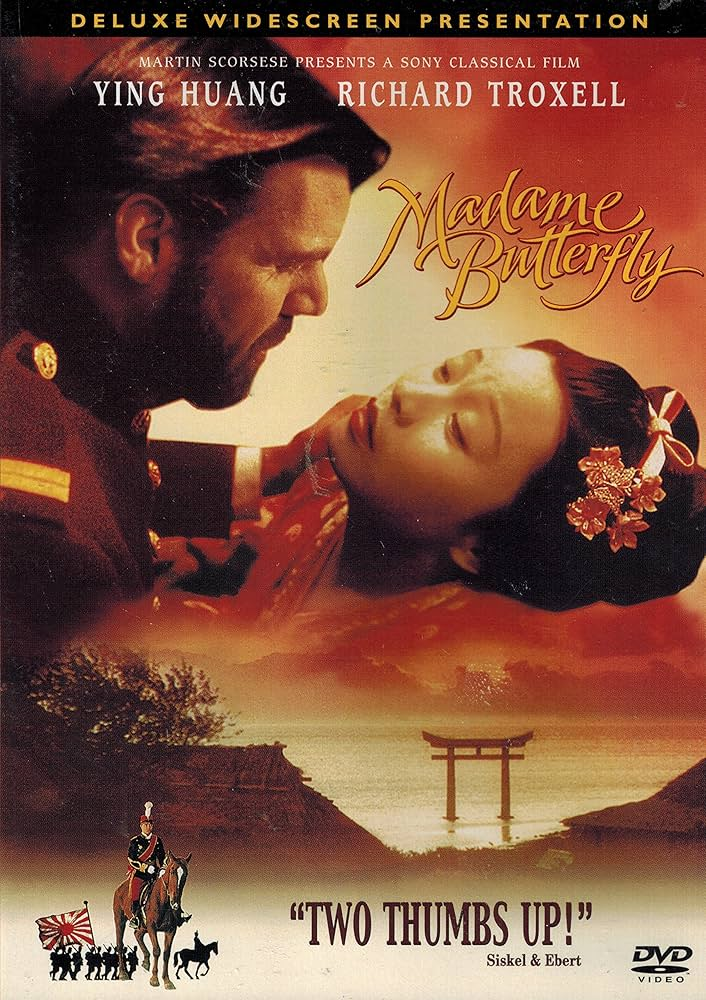Messaging and Hidden Meaning In Film Posters

For this post I want to focus on film posters. There is often a lot of hidden messaging and semiotics contained within posters, and for that reason I wish to examine them. For the purposes of this post I will be focusing on the film adaptation of Madame Butterfly directed by Martin Scorsese.
The realist perspective will be employed as the mode of analysis for the poster. As realism can be argued to be a function of narrative, it therefore lends a more useful means to exploring the signified meanings and connotations, particularly the racial significations, within the presented poster and the film it depicts. As regards representation realism has a well established history of creativity and criticality. In relation to realism and the novel Professor Furst states that:
‘realism cannot……vouchsafe access to an innocent, uncoded or objective experience of an independently existing real world'.
What makes realism more intriguing is due to its focus on language which can be used in a multitude of ways to build meaning, convey messages or construct narrative. Therefore reality and the illusion of reality are at the centre of the analysis of the Madame Butterfly poster.
If we look at the Madame Butterfly poster for a moment, a film of the opera with the same name written by Giacomo Puccini, we are presented with a woman, perhaps of Chinese or Japanese orientation, being embraced by a white man in uniform. However the nature of the embrace is ambiguous and it is unclear as to whether these two characters are lovers, partners or husband and wife.
The intimacy between the man and the woman is vague and somewhat distant, there is a kind of strained passion within the poster narrative. The image also connotes a theme of power and the woman looks the weaker of the two characters, she looks fragile perhaps vulnerable, almost portraying a traditional stereotypical female role. The male looks the more powerful, his uniform helps to achieve this but not entirely, she is looking up at him maybe helpless, and he is offering her support and in the picture seems as if he is physically holding her. Is she madly in love with this man? Does he not feel the same way about her? Is he committed elsewhere?
The ‘powerful’ white man in uniform clutching the ‘weaker’ oriental woman could also signify a sense of colonialism, perhaps from the days of the British Empire when it colonized Honk Kong and other areas of Asia. It is as if the historical fact of imperialism is now being kept alive, and in so doing emphasizing Edward Said’s observation about Oriental cultures and the requirement of examining these without a filter of inferiority or superiority.
Peace!
Orientalism, in one word. I generally lump all orientalism into the white savior stories (like Dances with Wolves and the Last Samurai) and dismiss it as white people fantasy, dreaming of when it was acceptable to pretend they were superior to all other races. That said, Madame Butterfly has been successfully performed in Japan for years, so reaction to it is definitely mixed and not all bad.
I won't pretend I know the full history of orientalism. However, what I also won't ignore is the huge contribution Western civilisation has made to the world. Yes of course there are darker sides to it, just like with all civilisations.
Fortunately Madame Butterfly still survives, despite rampant political correctness. What's sad about the demise of Western civilisation is that it is being done from within.
It's a complex situation and nuance is definitely needed. It's not all good or all bad. Western civilization did contribute a lot to the modern world, but the rise of the west was funded by stealing from and exploiting the east. Again, nuance is needed, and it's certainly true that had the west not exploited the east, the reverse may have happened. It is the story of humanity after all. But speculation like that is much harder to do and it's always best to just work with the facts.
At any rate, unwinding all of this is always tough, in a large part because so many people take offense at just about everything, reading much more into what is said that what is intended, and so it's really hard to talk about. Everyone loves to talk about the good things their culture has done, but they get uptight when we talk of the bad things their culture has done and they want to lash out at others. Again, nuance is needed. We should be able to separate ourselves enough to see both the good and the bad in all cultures, including our own. That is the mark of a good historian, one who is able to talk about all sides, even their own, while keeping an open mind and not allowing their bias to get in the way.